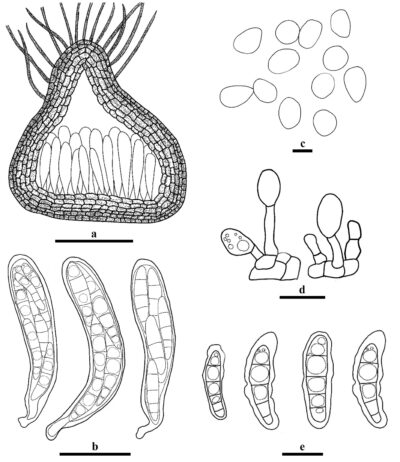Fungalpedia – Note 403, Hongkongmyces
Hongkongmyces C.C.C. Tsang, J.F.W. Chan, Trend.-Sm., A.H.Y. Ngan, I.W.H. Ling, S.K.P. Lau & P.C.Y. Woo
Citation when using this data: Tibpromma et al. 2024 (in prep.) – Fungalpedia, Ascomycota.
Index Fungorum, Facesoffungi, MycoBank, GenBank, Fig. 1
Classification: Lindgomycetaceae, Pleosporales, Pleosporomycetidae, Dothideomycetes, Pezizomycotina, Ascomycota, Fungi.
Based on phylogenetic analysis of ITS, LSU, TUB, and TEF1-α, Tsang et al. (2014) introduced Hongkongmyces as a monotypic genus within Lindgomycetaceae with the type species Hongkongmyces pedis, which was reported as a pathogen of a foot nodule biopsy of a human with suppurative granulomatous in Hongkong, China. The type species is characterized by gray colonies composed of gray, narrow, septate, branched hyphae with acute angles, and sterile mycelia with no fruiting bodies or conidia produced (Tsang et al. 2014). Hyde et al. (2017) introduced Hongkongmyces thailandicus as the second species, and described the sexual morph of Hongkongmyces, with globose, short-papillate ascomata, cylindrical to clavate asci, and hyaline, fusiform to cylindrical ascospores with a mucilaginous sheath. The asexual morph of Hongkongmyces snookiorum was isolated from submerged wood, with globose to ampulliform pycnidia, hyaline, subulate to ampulliform conidiogenous cells with sympodial proliferations, hyaline, ellipsoid to ovoid conidia (Crous et al. 2018). Currently, eight species are included in this genus, which are commonly associated with freshwater habitats as saprobes; i.e., Hongkongmyces aquaticus, Hongkongmyces aquisetosus, Hongkongmyces brunneisporus, Hongkongmyces changchunensis, Hongkongmyces kokensis, H. pedis, H. snookiorum, and H. thailandicus (Tsang et al. 2014, Hyde et al. 2017, Crous et al. 2018, Dong et al. 2020, Bao et al. 2021, Boonmee et al. 2021, Jayawardena et al. 2022, Yang et al. 2023).
Type species: Hongkongmyces pedis C.C.C. Tsang, J.F.W. Chan, N.J. Trendell-Sm., A.H.Y. Ngan, I.W.H. Ling, K.Y. Yuen, S.K.P. Lau & P.C.Y. Wood
Other accepted species: Species Fungorum – search Hongkongmyces
Figure 1 – Morphological features of Hongkongmyces. a Ascomata. b Asci. c Conidia. d Conidiogenous cells and developing conidia. e Ascospores. Scale bars: a = 100 μm, b =50 μm, c–e =20 μm. Redrawn from Hyde et al. (2017) and Jayawardena et al. (2022).
References
Entry by
Liu XF, Center for Yunnan Plateau Biological Resources Protection and Utilization, College of Biological Resource and Food Engineering, Qujing Normal University, Qujing, Yunnan 655011, China; Center of Excellence in Fungal Research, Mae Fah Luang University, Chiang Rai 57100, Thailand; School of Science, Mae Fah Luang University, Chiang Rai 57100, Thailand.
(Edited by Saowaluck Tibpromma, Samaneh Chaharmiri-Dokhaharani, & Achala R. Rathnayaka)
Published online 26 November 2024
